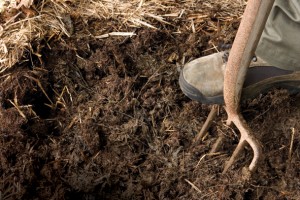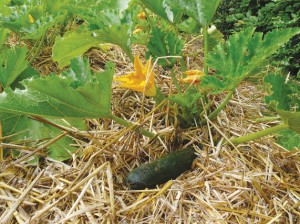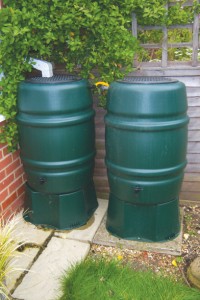Get Waterwise!
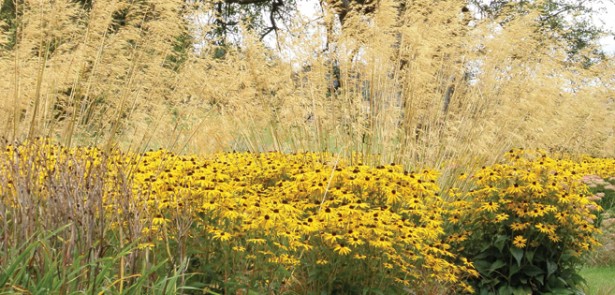
Hot and dry – or a washout? Nobody knows how this summer will pan out but it’s as well to be prepared. Benedict Vanheems has the lowdown on drought-tolerant plants and how to use water wisely
If there’s one thing that can be accurately said about the weather so far this year, it’s that it has proved anything but predictable. Two years of way-below-average rainfall in our region saw a hosepipe ban implemented at the start of spring, only to be followed by the wettest April since records began. The British weather is well-known for its fickle nature, but this surely takes the biscuit!
It may seem perverse to be facing summer with a hosepipe ban after a period of squally rain. The reason, of course, is that it takes time for underground water levels to be recharged after successive months of low rainfall. The last time we faced such a chronic depletion of water levels was during the notoriously hot and dry summer of 1976. It was only when the government appointed Denis Howell as special Minister for Drought that the dry spell finally came to a spectacular conclusion; days of heavy rain and widespread flooding followed. Denis was promptly appointed Minister for Floods (you couldn’t make this stuff up!).
Changeable times
Writing this a few weeks before the onset of summer proper it’s hard to tell whether we’re in for a cool, damp summer (one of the Met Office’s notorious ‘barbeque summers’!) or a sizzler complete with record temperatures and wall-to-wall sunshine. That’s the thing about the Great British Summer – no-one can accurately predict what’s around the corner.
Just as one hot summer doesn’t necessarily mean our climate is changing, a couple of dry winters do not mean the future is one of perpetual drought. You have to look back over several decades to pick up trends in our weather. One body that is coordinating research into the future of the British climate is the UK Climate Impacts Programme. Extrapolating recent trends in climate would suggest we are in for increasingly hotter, drier summers and warmer, wetter winters (see table). Gardeners will need to work with these changes, adapting what they grow and how they grow if their gardens are to continue to thrive. In the meantime anomalies and record-breaking weather events are sure to become a common feature.
| Change Year |
Winter temperature | Winter precipitation | Summer temperature | Summer precipitation |
| 2020 | +1.3°C | +6% | +1.4°C | -7% |
| 2050 | +2.2°C | +14% | +2.5°C | -17% |
| 2080 | +3.0°C | +20% | +3.6°C | -21% |
Summer heat

Hotter summers will suit plants such as the appropriately-named red hot poker down to the ground.
Pic Credit: Jill Clardy
Whether or not we bask in a Mediterranean-style summer this year is anyone’s guess. I certainly won’t be putting any money on it! That said it is clear that summers will become gradually warmer and more settled over the long run (which is no bad thing for al fresco dining enthusiasts). It is, perhaps, not such good news for our native wildlife and traditional English gardens. What we plant in our gardens will have to evolve with the climate. The focus, increasingly, will be on those plants that can come through a hot, dry summer unscathed.
Many common garden plants are already well-adapted to a future of warmer, dryer summers. Plants with silvery or grey leaves are generally designed for the heat, their paler leaves helping to reflect some of the sun’s rays and prevent the plant from overheating. Some of these silver-leaved plants also have a slightly furry covering. This helps to further shade the foliage while trapping valuable moisture.
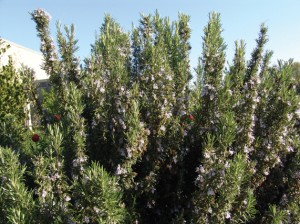
Resinous herbs such as rosemary are well adapted to dryer, free-draining soils.
Pic Credit: Drew Avery
Those shrubs and trees with firm, waxy leaves also tend to fare well in dryer conditions, as do succulent-style plants such as the fleshy-leaved sedums (the leaves soak up water when it’s available for use during dryer spells). A number of our favourite herbs are already suited to a future of balmier conditions with the likes of rosemary, thyme and sage all preferring well-drained, sun-baked corners of the garden.
An excellent local source of drought-tolerant plants is Olive Grove Nurseries in Polebrook, Northamptonshire. The nursery specialises in Mediterranean shrubs, exotic plants and hardy tropicals, many of which we’ll be seeing more of in the coming years. The nursery is open Tuesdays to Saturdays from 10am to 5pm and on Sundays from 11am to 4pm. For further details and directions visit www.olivegrovenurseries.co.uk or give them a buzz on 01832 275660.
Soil preparation
Of course, you don’t necessarily want to limit yourself to plants from more arid climes – half the secret to coping with a hot, dry summer lies in soil preparation and attention paid here will dramatically expand what you can successfully get away with.
Any ground destined for new plants should be thoroughly prepared beforehand. In almost all cases soil will benefit from having plenty of organic matter dug in. This includes the likes of garden-made compost and well-rotted manure. Digging in ample goodness such as this works for both free-draining, sandy soil and heavy, claggy clay soils. For the former the additional organic matter will help to improve the soil’s water-retaining ability while adding valuable nutrients; for the latter it will help to build a more open soil structure that will ensure the ground holds onto moisture but drains better during periods of prolonged rain. In other words, you really can’t fail to win – adding organic matter is as close to a panacea for all ills as you can get!
Existing borders can have organic matter added simply by spreading it around plants and leaving it in situ. This organic mulch not only look great (it’s amazing how a fresh layer of dark, crumbly material spruces up the appearance of the garden) but slows the evaporation of valuable soil moisture from the earth beneath. If your ground is dry then give it a thorough soaking before applying your mulch. This way you’ll trap the moisture in the ground where it’s needed. Don’t scrimp on how much you add – a generous layer of up to two or three inches will reward you with lusher, healthier plants. As time passes the earthworms and other soil dwellers will dig all that goodness in, saving you the hard work of doing so. Top up mulches periodically to keep the soil cool, nourished and weed-free.
Compost and well-rotted manure make excellent mulches as they have a good base level of nutrients to them. If you haven’t got enough to go round you can, of course, use other materials. Grass clippings (from herbicide-free lawns), chipped bark and even hay will all help to lock in soil moisture and will eventually rot down into the ground. Soil that’s rich in organic matter tends to level out the peaks and troughs of wet and dry, thereby creating more predictable conditions for plants.
Harvest the skies

Fit gutters to sheds and greenhouses to maximise the potential for harvested rainwater.
Pic Credit: Lee Jordan
Treated tap water requires a lot of energy to distribute, it’s costly and it isn’t ideal for garden plants. It is far better to collect rainwater from roof surfaces (garage, house, shed and greenhouse) for use in the garden. Any rainwater collected this way can be used as you please – no need to worry about hosepipe bans! Use it to fill watering cans, to supply a micro-irrigation system or to attach a hosepipe to.
Rainwater can be intercepted from a downpipe by fitting a rainwater diverter. This will divert water away from the downpipe to your water storage device of choice. Water butts can be linked together by a short length of pipe or hose at the top of the butts, doubling capacity in an instant. It’s easy to fit a gutter and downpipe to a greenhouse or shed using a series of brackets and a spirit level to ensure a very slight gradient so that the water flows away easily. Open-ended barrels and containers can be used with greenhouses and sheds, while fully enclosed water butts will prevent loss of collected water through evaporation. Raise any water butt you use above ground level by sitting it on a purpose-made base, breeze blocks or similar – this way you can pop a watering can underneath.
Don’t forget ‘grey water’ either. This is simply any domestic waste water arising from baths/showers and the kitchen. The water should be relatively ‘clean’ – so don’t use water chock full of detergent, fats or chemical-heavy washing products. When saving and using grey water always aim to use eco-friendly products that will quickly break down. Use grey water immediately and only ever slosh it onto ornamental plants or around fruit trees – not on vegetables. Bath water can be siphoned off via a hose to water thirsty garden beds.
The more water we can collect or reuse the better. All that ‘free’ water can be used guilt-free and your garden will love you for it!
How to water
If you have to water your garden then do so wisely. Follow these five dos and don’ts.
1 Don’t water unless you have to! Lawns that turn brown during a dry spell always recover and most wilting perennial plants will spring back to life in the next rainstorm.
2 Don’t water during the heat of the day. Early in the morning or late in the evening is best, when conditions are cooler and less of that moisture will evaporate.
3 Do water at the base of plants, closer to where the roots are. Water splashed willy-nilly over the leaves will just evaporate away or, worse still, act as an entry point to fungal diseases.
4 Do use water-efficient irrigation systems (not sprinklers!) with a timer. Porous pipes or micro-irrigation kits deliver water effectively and are exempt from the current hosepipe ban.
5 Do concentrate your water on young and recently planted plants, which won’t have established a proper root system as yet. Water copiously but less often to encourage the roots to seek out the moisture.



